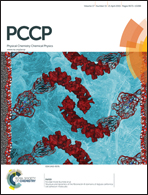Modification of the catalytic properties of the Au4 nanocluster for the conversion of methane-to-methanol: synergistic effects of metallic adatoms and a defective graphene support†
Abstract
Decorating graphene with nano-clusters offers potential for a wide range of industrial applications. For catalysis, embedding precisely controlled mono- and bimetallic nanoclusters into graphene can greatly increase their catalytic activities, especially for oxidation reactions. The catalytic performance of a gold nanocluster can be modified dramatically by changing its electronic properties. The results of this work demonstrate by means of DFT calculations that by strategic doping and promotion from the support material the catalytic activity improvement of a gold-based catalyst for the partial oxidation reaction of methane can be drastically enhanced. The transition metal-mediated catalysis is significantly affected by the two spin-state reactivities over them. The investigated catalytic processes consist of N2O decomposition and methane hydroxylation over three subnanoclusters (Au5, Au4Pd, and Au4Pt) deposited on a single vacancy graphene support. It was found that graphene acts not only as a support but also supports the catalysis through charge transfer between the subnanocluster and graphene. Graphene-supported Au4Pd exhibits enhanced catalytic activity for both steps of methane-to-methanol conversion, whereas the supported Au5 is good for N2O decomposition but ineffective for methane hydroxylation, mainly due to the involvement of a very stable intermediate (methyl-hydroxo-grafted nanocluster). The activation energies for N2O decomposition, C–H bond activation and methanol formation over the supported Au4Pd cluster are 13.8, 15.7, and 24.9 kcal mol−1, respectively. Without the graphene support, the catalytic trend is reversed and Au4Pd becomes an inert cluster for these reactions.


 Please wait while we load your content...
Please wait while we load your content...